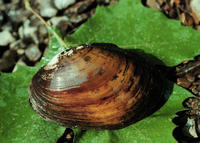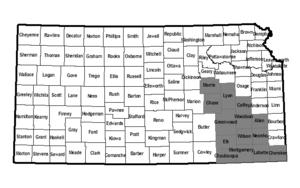NEOSHO MUCKET MUSSEL

This freshwater mussel is elongated with a slightly rounded shell. The shell is relatively thin, with a size of approximately 4 inches. There are prominent growth lines. The shell is light brown and has a dull, waxy luster; it usually becomes dark brown with age. Green rays usually cover the surface often chevron shaped during the first three years of growth.
The species is an obligate riverine species preferring shallow clean flowing water in fine to medium gravel substrates. Historically found in the Marais des Cygnes, Cottonwood, Spring, Neosho, Verdigris, Fall and Caney River systems. Currently appears to be extirpated from the Caney River and much reduced in numbers and distribution in the other river systems.

Neosho Mucket Mussels are protected by the Kansas Nongame and Endangered Species Conservation Act and administrative regulations applicable thereto. Any time an eligible project is proposed that will impact the species’ preferred habitats within its probable range, the project sponsor must contact the Ecological Services Section, Kansas Department of Wildlife and Parks, 512 SE 25th Ave., Pratt, Kansas 67124-8174. Department personnel can then advise the project sponsor on permit requirements.
DESIGNATED CRITICAL HABITATSAs defined by Kansas Administrative Regulations, critical habitats include those areas documented as currently supporting self-sustaining population(s) of any threatened or endangered species of wildlife as well as those areas determined by the Kansas Department of Wildlife, Parks and Tourism to be essential for the conservation of any threatened or endangered species of wildlife.
Currently, the following areas are designated critical for Neosho Mucket:
- Neosho River: from the Morris-Lyon county line to the maximum elevation of John Redmond Lake; from John Redmond dam to Kansas-Oklahoma border (Coffey, Woodson, Allen, Neosho and Labette Co.).
- Spring River: from where the Spring River first enters Kansas to the backwater of Empire Lake; from Empire Lake dam to the Kansas-Oklahoma border. (Cherokee Co.).
- Fall River: from the confluence of Spring Creek (south of Eureka) to Fall River Lake: from Fall River dam to its confluence with the Verdigris River (Greenwood, Elk and Wilson Co.).
- Verdigris River: from Virgil to the confluence of West Creek (Greenwood County); from Toronto Lake dam to the Kansas-Oklahoma border (Wilson and Montgomery Co.).
- Neosho River: from the Morris-Lyon county line to John Redmond Lake; from Parsons city dam to the Kansas-Oklahoma border (Morris, Lyon, Labette and Cherokee Co.).
- Cottonwood River: from Elmdale to the river’s confluence with the Neosho River (Chase and Lyon Co.).
- South Fork of the Cottonwood River: from Bazaar to the river's confluence with the Cottonwood River (Chase Co.).
- Spring River: from the confluence of Turkey Creek to the backwater of Empire Lake; from Empire Lake dam (Cherokee Co.) to the Kansas-Oklahoma border.
- Shoal Creek: from the Kansas-Missouri border to Empire Lake (Cherokee Co.).
- Big Caney River: from US-166 (Chautauqua Co.) to the Kansas-Oklahoma border.
- Elk River: from Elk Falls (Elk Co.) to Elk City Lake (Montgomery Co.).
- Fall River: from K-99 to Fall River Lake (Greenwood Co.).
- Verdigris River: from Toronto Lake dam to K-47 (Wilson Co.), and from the city of Coffeyville (Montgomery Co.) to the Kansas-Oklahoma border.







